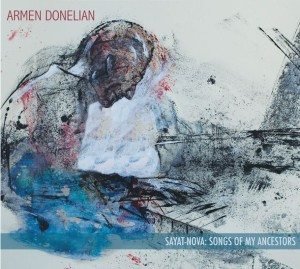Armen Donelian
Sayat Nova: Songs of My Ancestors
Sunnyside Records
Release: April 15, 2014
New York-based jazz pianist Armen Donelian’s latest album proves it is possible to celebrate Armenia’s rich cultural history from a contemporary perspective. The album “Sayat Nova: Songs of My Ancestors,” to be released nine days before the 99th memorial of the 1915 genocide, pays tribute to the 18th-century Armenian poet and troubadour’s revered original melodies, but does not shy away from more modern influences, most notably, mainstream jazz and classical music.

Having arrived in Armenia for the first time in 1998 as a performer at Yerevan’s First International Jazz Festival, Donelian saw a unique opportunity and applied for a Fulbright Research Grant to return for a more extended period. Despite immediate obstacles, ranging from basic language barriers to more complex ideological ones, Donelian’s return in 2002 saw him teaching the first formal course in American jazz, bebop style piano at Yerevan’s Komitas State Conservatory. He brought with him resources for jazz pedagogy and started a small jazz library in the conservatory at a time when, as he puts it, “materials had a tendency to disappear.” His time in Armenia has made an impact on not only his own personal musical aspirations, but also on current generations of Armenian musicians.
What inspired Donelian’s selection of Sayat Nova as the center of this project? Although the name Sayat Nova is familiar to Armenian households across the globe, his persona is shrouded in obscurity. Yet his contributions to Armenian literature have often been “compared to Shakespeare’s” and in music, “the beauty of his melodies rank with those of the greatest European composers.”
Donelian’s humility and appreciation for what Sayat Nova’s legacy represents to the Armenian community is apparent in the album’s booklet, he says. “I did not change this music. It changed me.” Sayat Nova’s music is just one piece of a puzzle within the larger scheme of Armenia’s vast cultural achievements, and Donelian’s liner notes place the music within a larger framework of the poet’s life and continuing legacy. The booklet is also replete with reflections and comments by Donelian himself on the album’s music.
Adapting the traditional folk melodies to solo piano was not always an easy task for Donelian. In a Skype interview, he explained some of these obstacles in greater depth: “The problem as a pianist is twofold. One…what you’re trying to do is imitate on a well-tempered instrument the sound of music that was created on a mobile instrument. That’s number one. Number two is that most of this music, at least in its original, folk form, is monadic. That is, it’s only a single line of music. Then, harmonies are only implied by the path of the melody. So, as we listen to that melody, we might get a sense of a harmonic or tonal center. But there’s no functional harmony… You know, when you encounter folk music of that nature, it’s quite a different mindset, a whole different approach. So, when I practice this music, what I’m trying to do is hear the music on its own terms, yet relate it somehow to the tradition and style that I’ve devoted my life to learning. And that’s taken some time. But I feel like with this new project of Sayat Nova music, I’ve done something that I’m really proud of and feel very good about. Because I’ve preserved the melodies of Sayat Nova, and infused them with harmonies that are truly contemporary.”
The incubation period for the album has been several years in the making, evident in Donelian’s skillful arrangements. Those for solo piano and jazz combo reflect a lifetime of musical encounters in and outside the realm of Armenian music. Some of the tracks on the album take on a highly classical character, as in “Tamam Ashkhar Bdood Eka,” which incorporates a wide range of 20th-century stylistic textures. Other songs, like “Tekouz Koo Kashn Markrit Tan,” draw heavily from Afro-Cuban elements, reminiscent of his time playing in Mongo Santamaria’s New York City jazz band in the 70’s. The album consists of two discs, with the second containing tunes arranged for jazz trio (piano, bass, and drums).
Fans of Soviet-Armenian composer Arno Babajanian might recognize the tune in the song “As I Draw Breath,” which is the same heart-wrenchingly melancholic folk melody Babajanian used in his solo piano piece, “Elegia.”
In a modern world in which the music of other cultures is so often trivialized and appropriated for the music industry’s commercial objectives, “Sayat Nova: Songs of My Ancestors” is a breath of fresh air. Its integration of Armenian culture in this commercial context does not go unexplained. And though not every listener may make it through Donelian’s lengthy album liner notes that detail Sayat Nova’s past, its presence on the album is a comforting testament to Donelian’s dedication to a larger cause: the present state of Armenia’s culture, as well as its future.



Be the first to comment